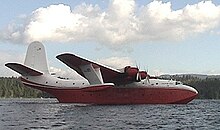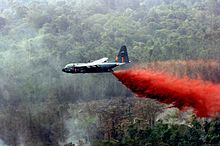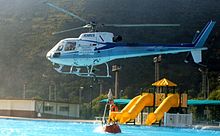Aerial firefighting: Difference between revisions
→Airtankers: rmv unsourced urban legend |
|||
| Line 17: | Line 17: | ||
'''Airtankers''' or '''water bombers''' are fixed-wing aircraft fitted with tanks that can be filled on the ground at an air tanker base or, in the case of [[flying boat]]s and [[amphibious aircraft]], by skimming water from lakes, reservoirs, or large rivers. |
'''Airtankers''' or '''water bombers''' are fixed-wing aircraft fitted with tanks that can be filled on the ground at an air tanker base or, in the case of [[flying boat]]s and [[amphibious aircraft]], by skimming water from lakes, reservoirs, or large rivers. |
||
Various aircraft have been used over the years for firefighting. Though [[World War II]] era [[bomber]]s were for a long time the mainstay of the aerial firefighting fleet, newer purpose-built tankers are coming online. The smallest are the [[Single Engine Air Tankers]] (SEATs). These are agricultural sprayers that generally drop about 800 gallons of water or retardant. Medium aircraft include the [[S-2 Tracker]] ([[retrofit]]ted with turboprop engines as the S-2T) as used by the [[California Department of Forestry & Fire Protection]] (CDF), as well as [[Conair Group Inc.]] of [[Abbotsford, British Columbia]], while the [[Douglas DC-4]], the DC-7, the [[Lockheed]] [[C-130 Hercules]], [[P-2V Neptune]], [[P-3 Orion]] and others have been used as heavy tankers. The largest aerial firefighters currently in use include two converted [[Martin Mars]] [[flying boats]] in [[British Columbia]] (one of which was brought to southern California in September 2007 to help battle the wildfires there), carrying 7,200 U.S. gallons of water or fire retardant each, and [[Tanker 910]], a converted [[McDonnell Douglas DC-10]] that can carry 12,000 gallons of water or retardant. The [[Russia]]n [[Ministry of Emergency Situations]] operates convertible-to-cargo [[IL-76]] airtankers that can carry up to 15,000 gallons but have been operating with 11,000 gallon tanking systems, and [[Evergreen International Aviation]] is developing a [[Boeing 747]] aerial firefighter, known as the [[Evergreen Supertanker]] that can carry 24,000 gallons fed by a pressurized drop system. |
Various aircraft have been used over the years for firefighting. Though [[World War II]] era [[bomber]]s were for a long time the mainstay of the aerial firefighting fleet, newer purpose-built tankers are coming online. The smallest are the [[Single Engine Air Tankers]] (SEATs). These are agricultural sprayers that generally drop about 800 gallons of water or retardant. Medium aircraft include the [[S-2 Tracker]] ([[retrofit]]ted with turboprop engines as the S-2T) as used by the [[California Department of Forestry & Fire Protection]] (CDF), as well as [[Conair Group Inc.]] of [[Abbotsford, British Columbia]], while the [[Douglas DC-4]], the DC-7, the [[Lockheed]] [[C-130 Hercules]], [[P-2V Neptune]], [[P-3 Orion]] and others have been used as heavy tankers. The largest aerial firefighters currently in use include two converted [[Martin Mars]] [[flying boats]] in [[British Columbia]] (one of which was brought to southern California in September 2007 to help battle the wildfires there), carrying 7,200 U.S. gallons of water or fire retardant each, and [[Tanker 910]], a converted [[McDonnell Douglas DC-10]] that can carry 12,000 gallons of water or retardant. The [[Russia]]n [[Ministry of Emergency Situations]] operates convertible-to-cargo [[IL-76]] airtankers that can carry up to 15,000 gallons but have been operating with 11,000 gallon tanking systems, and a few of [[Beriev Be-200]] amphibians. [[Evergreen International Aviation]] is developing a [[Boeing 747]] aerial firefighter, known as the [[Evergreen Supertanker]] that can carry 24,000 gallons fed by a pressurized drop system. |
||
Bombardier's [[De Havilland Canada Dash 8|Dash 8 Q Series]] aircraft are the basis for two new ventures. [[Cascade Aerospace]] has converted two pre-owned Q400s to act as part-time water bomber and part-time transport for [[France]]'s [[Sécurité Civile]], one of which is registered [http://www.airliners.net/open.file/896286/M/ F-ZBMC], while [[Neptune Aviation]] is converting a pre-owned Q300 as a prototype to augment their [[P2V Neptune|P2V]] aircraft. |
Bombardier's [[De Havilland Canada Dash 8|Dash 8 Q Series]] aircraft are the basis for two new ventures. [[Cascade Aerospace]] has converted two pre-owned Q400s to act as part-time water bomber and part-time transport for [[France]]'s [[Sécurité Civile]], one of which is registered [http://www.airliners.net/open.file/896286/M/ F-ZBMC], while [[Neptune Aviation]] is converting a pre-owned Q300 as a prototype to augment their [[P2V Neptune|P2V]] aircraft. |
||
| Line 29: | Line 29: | ||
French "[[Sécurité Civile]]" owns the entire Canadian CL-xx series, a handful of Grumman Trackers and some Russian [[Mil Mi-6|helicopters]], [http://fr.wikipedia.org/wiki/Mil_Mi-6 French] version more exhaustive. Their pilots are usually recruited amongst the best pilots from "l'Armée de l'Air", usually from "Aéronavale" (Navy pilots on aircraft carriers) or acrobatic teams like "La Patrouille de France". It is a highly risked job that requires very skilled aerial fighters. |
French "[[Sécurité Civile]]" owns the entire Canadian CL-xx series, a handful of Grumman Trackers and some Russian [[Mil Mi-6|helicopters]], [http://fr.wikipedia.org/wiki/Mil_Mi-6 French] version more exhaustive. Their pilots are usually recruited amongst the best pilots from "l'Armée de l'Air", usually from "Aéronavale" (Navy pilots on aircraft carriers) or acrobatic teams like "La Patrouille de France". It is a highly risked job that requires very skilled aerial fighters. |
||
Another amphibian is |
Another amphibian is Russian [[Beriev Be-200]]. It can carry a maximum payload of about 3,170 gallons (12,000 litres) of water, making "scoops" in suitable stretches of water in 14 seconds. It was successfully used to fight fires in the southern European countries such as Greece and Portugal. |
||
===Leadplanes=== |
===Leadplanes=== |
||
Revision as of 00:16, 21 October 2008

Aerial firefighting is a method to combat wildfires using aircraft. The types of aircraft used may be either fixed-wing or helicopters. Agents used to fight fires may be either water or specially-formulated fire retardants. Smokejumpers and rappellers are also classified as aerial firefighters, being delivered by parachute from a variety of fixed-wing aircraft, or rappelling from various helicopters.
Terminology
A wide variety of terminology has been used in the popular media for the aircraft used in aerial firefighting, as well as the methods used. The terms Airtanker or air tanker generally refer to fixed-wing aircraft, with "airtanker" being the form used in official documentation.[1][2] The popular media also frequently uses the terms water bomber, fire bomber or borate bomber as well. Helicopters and their methods of operation is properly referred to as helitack.[2]
Air attack is an industry term used for the actual application of aerial resources, both airtanker and helitack, on a fire, although colloquially, "air attack" is also a term used for the airborne manager in a spotter plane who is charged with directing the use of the aerial resources. Initial attack refers to the first-response of aerial assets to suppress a fire before it grows out of control; aviation assets can usually respond to a reported blaze much quicker than ground elements, especially for wilderness fires. Extended attack refers to the continued use of aerial assets on an out-of-control fire, primarily to assist ground units in the establishment of firelines in advance of the fire.[2]
Equipment
A wide variety of helicopters and fixed-wing aircraft are used for aerial fighting. In 2003, it was reported that "The U.S. Forest Service and Bureau of Land Management own, lease, or contract for nearly 1,000 aircraft each fire season, with annual expenditures in excess of US$250 million in recent years".[3]
Helicopters
Helicopters may be fitted with tanks or carry buckets. Buckets are usually filled by submerging in lakes, rivers, reservoirs, or portable tanks. The most popular of the buckets is the flexible Bambi Bucket. Tanks may be filled on the ground or water may be siphoned from lakes or reservoirs through a hanging snorkel. Popular firefighting helicopters include variants of the Bell 204 and the Erickson S-64 Aircrane helitanker, which features a sea snorkel for filling while in flight.
Airtankers

Airtankers or water bombers are fixed-wing aircraft fitted with tanks that can be filled on the ground at an air tanker base or, in the case of flying boats and amphibious aircraft, by skimming water from lakes, reservoirs, or large rivers.
Various aircraft have been used over the years for firefighting. Though World War II era bombers were for a long time the mainstay of the aerial firefighting fleet, newer purpose-built tankers are coming online. The smallest are the Single Engine Air Tankers (SEATs). These are agricultural sprayers that generally drop about 800 gallons of water or retardant. Medium aircraft include the S-2 Tracker (retrofitted with turboprop engines as the S-2T) as used by the California Department of Forestry & Fire Protection (CDF), as well as Conair Group Inc. of Abbotsford, British Columbia, while the Douglas DC-4, the DC-7, the Lockheed C-130 Hercules, P-2V Neptune, P-3 Orion and others have been used as heavy tankers. The largest aerial firefighters currently in use include two converted Martin Mars flying boats in British Columbia (one of which was brought to southern California in September 2007 to help battle the wildfires there), carrying 7,200 U.S. gallons of water or fire retardant each, and Tanker 910, a converted McDonnell Douglas DC-10 that can carry 12,000 gallons of water or retardant. The Russian Ministry of Emergency Situations operates convertible-to-cargo IL-76 airtankers that can carry up to 15,000 gallons but have been operating with 11,000 gallon tanking systems, and a few of Beriev Be-200 amphibians. Evergreen International Aviation is developing a Boeing 747 aerial firefighter, known as the Evergreen Supertanker that can carry 24,000 gallons fed by a pressurized drop system.
Bombardier's Dash 8 Q Series aircraft are the basis for two new ventures. Cascade Aerospace has converted two pre-owned Q400s to act as part-time water bomber and part-time transport for France's Sécurité Civile, one of which is registered F-ZBMC, while Neptune Aviation is converting a pre-owned Q300 as a prototype to augment their P2V aircraft.


Similar in configuration to the World War II-era PBY Catalina, the Canadair CL-215 Scooper, and Bombardier CL-415 SuperScooper are designed and built specifically for firefighting. The "Super Scoopers" are not common in the United States where only 2 operate seasonally in southern California. Los Angeles County leases two CL-415s from the Province of Québec during the fall when the Santa Ana winds are at their worst. 6 American owned CL-215s operate for various State and Federal agencies. Critics of scoopers in the US claim that there is not enough suitable water in fire prone states. CL-215s have been employed with success in North Carolina, Minnesota, Michigan, Wisconsin, Washington, Alaska, Northern Idaho, and Montana.
French "Sécurité Civile" owns the entire Canadian CL-xx series, a handful of Grumman Trackers and some Russian helicopters, French version more exhaustive. Their pilots are usually recruited amongst the best pilots from "l'Armée de l'Air", usually from "Aéronavale" (Navy pilots on aircraft carriers) or acrobatic teams like "La Patrouille de France". It is a highly risked job that requires very skilled aerial fighters.
Another amphibian is Russian Beriev Be-200. It can carry a maximum payload of about 3,170 gallons (12,000 litres) of water, making "scoops" in suitable stretches of water in 14 seconds. It was successfully used to fight fires in the southern European countries such as Greece and Portugal.
Leadplanes
The O-2 Skymaster and OV-10 Bronco are used as spotters. The Beechcraft Baron was long used as a lead plane or air attack ship, but most were retired in 2003; more common now is the Beech King Air, used as an air attack ship and lead plane.
Fleet grounding
In the United States, most of these aircraft are privately owned and contracted to government agencies, and the National Guard and the U.S. Marines also maintain fleets of firefighting aircraft. On May 10 2004, The U.S. Forest Service (USFS) and the Bureau of Land Management (BLM) suddenly announced that they were cancelling contracts with operators of 33 heavy airtankers. They cited liability concerns and an inability to safely manage the fleet after the crash of a C-130A Hercules in California and a PB4Y-2 in Colorado during the summer of 2002. Both aged aircraft broke up in flight due to catastrophic fatigue cracks at the wing roots.

Fire retardant
Borate salts were used in the past to fight wildfires but were found to sterilize the soil and were toxic to animals. Newer retardants use ammonium sulfate or ammonium polyphosphate with attapulgite clay thickener or diammonium phosphate with a guar gum derivative thickener. These are not only less toxic but act as fertilizers to help the regrowth of plants after the fire (however, the retardants can be toxic to fish if accidentally dropped in water and then exposed to sunlight). Fire retardants contain wetting agents, preservatives and rust inhibitors and are colored red with ferric oxide to mark where they have been dropped. Brand names of fire retardants for aerial application are Fire-Trol and Phos-Chek.
Some water-dropping aircraft carry tanks of a guar gum derivative to thicken the water and reduce runoff.
Tactics


Helicopters can hover over the fire and accurately drop water or retardant. The S-64 Helitanker has microprocessor-controlled doors on its tank. The doors are controlled based on the area to be covered and wind conditions. Fixed-wing aircraft must make a pass and drop water or retardant like a bomber. Spotter aircraft often orbit the fire at a higher altitude to coordinate the efforts of the retardant-dropping aircraft. Lead planes fly ahead of larger airtankers to mark the trajectory for the drop.
Water is often dropped directly on flames because its effect is short-lived. Fire retardants are typically dropped ahead of the moving fire or along its edge and may remain effective for two or more days. This can create an artificial firebreaks where the terrain is too rugged or remote for ground crews to cut fireline.
Helicopters are also used to deliver firefighters or ignite backfires and controlled burns. A driptorch slung beneath the helicopter (helitorch) can be used for this purpose. Another device called a Delayed Aerial Ignition Device (DAID) can be used, which shoots a stream of flaming "ping-pong balls" into the forest. The small plastic spheres which contain potassium permanganate are individually injected with ethylene glycol or glycerine just before they are ejected from the aircraft. This method's delayed oxidation reaction (which results in vigorous fire in just minutes after mixing the chemicals [1]) poses less of a danger to the helicopter than carrying along materials which are already burning. The ping-pong ball system works best in continuous fuels or in areas where a mosaic burn pattern is desired.
Aerial firefighting is almost always used in conjunction with ground-based efforts, as aircraft are only one weapon in the firefighting arsenal. However, there have been cases of aircraft extinguishing fires long before ground crews were able to reach them.
See also
References
- ^ Transcript of USA vs Fuchs, case 9810173, 9th Circuit U.S. Court of Apeals
- ^ a b c "Interagency Standards for Fire and Aviation Operations 2007, Chapter 17" (PDF). National Interagency Fire Center. Retrieved 2007-08-31.
- ^ Statement of Larry Hamilton National Director, Office of Fire and Aviation, Department of the Interior, Bureau of Land Management, National Interagency Fire Center Oversight Hearing: Blue Ribbon Panel Report and Aerial Firefighting Safety Senate Energy and Natural Resources Committee Subcommittee on Public Lands and Forests, March 26, 2003, retrieved September 27, 2007
